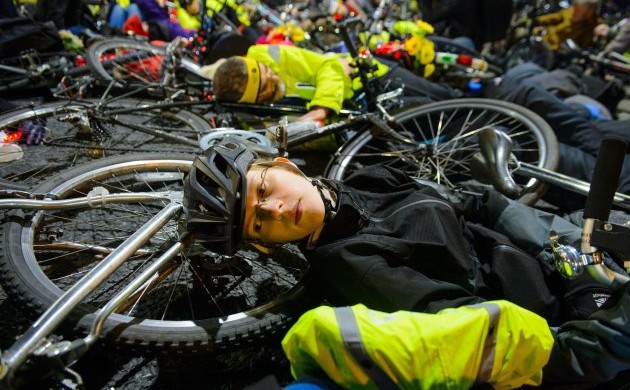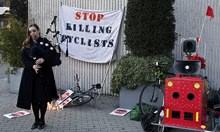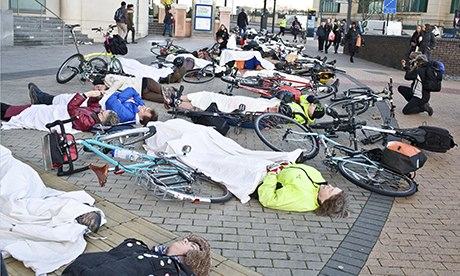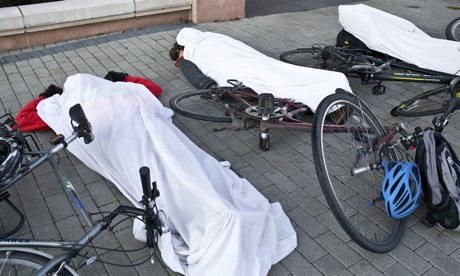
Good news, bad news here. London cyclists (our compatriots across the pond) staged another “die-in” today at a bridge that has been perilous. Bad news is that this problem isn’t going away. Good news is that the Brit Cyclists are keeping the pressure up! I wish Bradley Wiggins or Chris Froome would join them on their next staged protest. Now that would make a difference!
I like the name that the organizing group for these “die-ins” has taken, ‘STOP KILLING CYCLISTS.” Very effective, right to the point and graphic like a Tarantino headline. We should take note. No b.s., no pussyfooting, tell it like it is. I also commend the group for incorporating music and performers into the protest. Sharing the artistic talents of cyclists is a great way to garnish attention and make the protest more than mere visual shock. Again, we should take note.
The effectiveness of “die-ins” is obvious. Look at the press it generates. Maybe we should all be doing this each and every time a cyclist is hit in our city.
The story also gets into a very sticky issue: Cyclists using the sidewalk. Seems that this bridge in London was such a peril that many cyclists were using the sidewalk, and being written up by the police for it.
I don’t know about you, but when necessary I have no hesitation about riding on the sidewalk, even though it’s against the law where I live. I’d rather get a ticket than clipped by a Range Rover going 40. Know what I mean? So far no tickets. My plan if an officer pulls me over for sidewalk riding? Tell him I was almost hit a few blocks back. Will he still right me a ticket? Maybe, but again, measure that against being assaulted by 3 tons of automotive weaponry. Call me “Sidewalk Steve” and its’ how I’m going to stay in certain parts of town. Not a fan of sharing pavement with the drinkers and the texters.
How about you? Do you ever use the sidewalk and risk the wrath of the local Police? Ever get cited?
Here’s the DIE-IN story from the Guardian Paper in the UK.
Cyclists stage ‘die-in’ at Vauxhall bridge over road safety
Cyclists gathered in London for protest over junction where riders and pedestrians have been killed in recent years
On Thursday morning around 60 cyclists gathered at the northbound turning onto Vauxhall Bridge in London and began to lay their bicycles in an orderly line along the pavement. A new cyclists’ die-in was underway.
The protest had been organised by new direct action campaign group Stop Killing Cyclists, the group responsible for a 1,000-strong die-in outside Transport for London’s offices at the end of November.
A number of cyclists and pedestrians have been killed or seriously injured at or on roads leading to this junction in recent years. Pedalling from the west you can use a segregated cycle path. At this corner, however, cyclists are forced to turn back into the road just at the point where it becomes most dangerous.
Activists have complained that, since the publicity about cyclist deaths back in November police officers engaged in the Met’s “Operation Safeway” have been pouncing on errant cyclists who choose to take the safer route on the pavement this corner, serving them up with fixed penalty notices.
Cycling on the pavement is against the highway code. However Paul Boateng, a Home Office minister when these fixed penalty notices were introduced, said at the time:

A piper plays a lament at the die-in at Vauxhall Bridge.
“The introduction of the fixed penalty is not aimed at responsible cyclists who sometimes feel obliged to use the pavement out of fear of the traffic, and who show consideration to other pavement users.
“Chief police officers, who are responsible for enforcement, acknowledge that many cyclists, particularly children and young people, are afraid to cycle on the road, sensitivity and careful use of police discretion is required.”
The campaign feels the junction is a good example of how poorly designed infrastructure creates hazards for cyclists and other road users. It also wishes to highlight how the recent police activity seems to be in contradiction to this ministerial guidance.
As the protesters organised themselves a singer, accompanied by classical guitar, performed for passers by. This was followed by poignant laments played by two bagpipers. The assembled cyclists listened to some words from two of the organisers, Donnachadh McCarthy and Steve Routley and then proceeded to lay down on the pavement and cover themselves with sheets for the die-in.
As the protest drew to a close a trumpeter the played the last post and the activists heard final speeches from, amongst others, Tom Kearny, a pedestrian victim of a serious bus accident that left him in a coma.

Cyclists lie down on the pavement at Vauxhall Bridge to protest about road safety.
Finally, Alison Higgs, another activist from the group, accused Boris Johnson of prioritising profit above cyclist and pedestrian safety. She also criticised Andrew Gilligan for dismissing the earlier protest of over 1,000 cyclists and speaking of a dialog with the deaf rather than dealing with the issue of funding.
Since the protest the campaign has announced that it has a meeting scheduled with Leon Daniels, managing director of Transport for London, on 21 January to discuss its list of 15 demands. Boris Johnson’s cycling commissioner, Andrew Gilligan, will also be in attendance. We await developments with interest.






